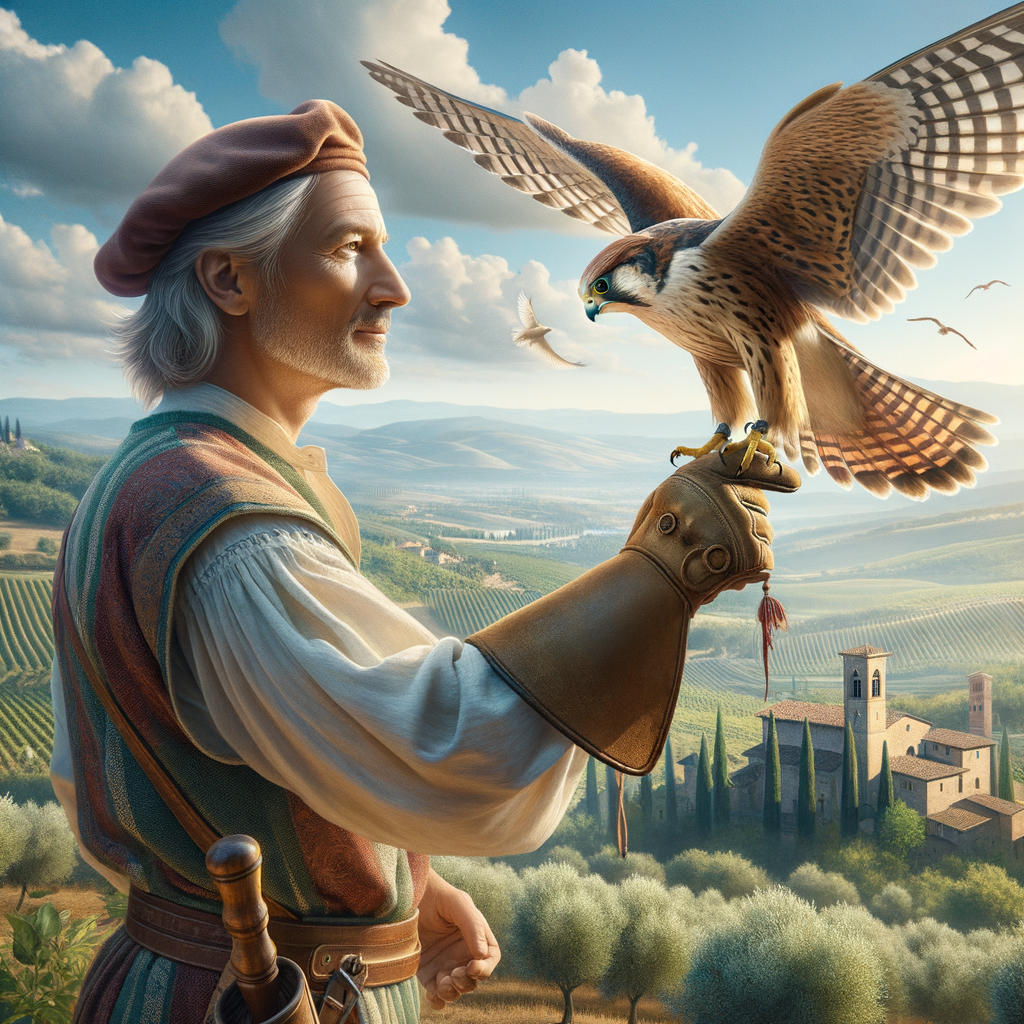Discovering the Fascinating World of Falconry and Italian Culture
- Ancient Art of Falconry: Falconry is a traditional practice with deep historical roots, where trained birds of prey, like falcons, are used to hunt wild animals.
- Cultural Significance in Italy: Falconry is not just a sport in Italy; it’s a cultural heritage passed down through generations, highlighting the bond between humans and nature.
- Training and Skills: Falconers must be skilled in training their birds, understanding their behavior, and building a trusting relationship, requiring patience and dedication.
- Falconry Equipment: Specialized tools like hoods, jesses, and gloves are essential for managing and protecting these magnificent birds during training and hunts.
- Natural Environment: Practicing falconry promotes a deeper appreciation for the natural world, emphasizing the importance of conservation and respect for wildlife.
- Educational Benefits: Learning about falconry opens up opportunities to educate others about history, wildlife, and the importance of preserving traditional practices.
- Community and Events: Falconry fosters a close-knit community where enthusiasts come together to share knowledge, participate in events, and celebrate their passion.
- Modern-Day Practice: Despite advances in technology, the principles of falconry remain largely unchanged, blending ancient techniques with modern conservation efforts.
Falconry in Italian Culture: A Timeless Tradition
Imagine you’re in the lush, green fields of Ireland, where the ancient art of storytelling is passed down through generations. Just like those enchanting Irish tales, falconry in Italy weaves its own magical narrative, blending history, culture, and nature. At Learn Falconry, we take pride in connecting you with these awe-inspiring traditions from around the world. Today, we’re diving into the heart of Italy’s unique falconry practices, uncovering why they’re as cherished as a pot of gold at the end of a rainbow.
Think of Italy, not just for its delicious pasta and rich art history but as a land where falconry has flourished since the medieval ages. From the majestic castles of Tuscany to the rolling vineyards of Sicily, falconry has been an important part of Italian culture, showcasing the harmonious relationship between humans and these magnificent birds of prey. But why is it so essential to keep reading?
Well, it’s because falconry in Italy is more than just a sport or pastime; it’s a living heritage that reveals the Italian people’s deep respect for nature and history. Much like the Irish appreciate a clever limerick or a heartwarming ballad, the Italians cherish falconry for its elegance, skill, and cultural significance. So, grab a cozy seat and let us take you on a fascinating journey through time, spanning centuries of dedication and passionate tradition that continue to soar in Italian skies today.
The Influence of Italian Falconry on Culture and Tradition
Italian falconry holds a rich history that adds a unique flavor to the cultural tapestry of the Italian Peninsula. Practiced for centuries, falconry in Italy intertwines with the nation’s art, literature, and daily life, creating a vibrant and longstanding tradition.
A Deep Dive into Italian Falconry Traditions
Falconry in Italy goes back to the medieval times when nobles and kings used falcons for hunting. The practice was more than just a sport; it was a symbol of status and power. Understanding these traditions helps us appreciate the depth of Italian falconry today. Visit History of Falconry for a broader context on how falconry evolved over time.
The art of Italian falconry involves various techniques and equipment to ensure a successful hunt and proper care for the birds. Essential gear includes hoods, gloves, and jesses, all of which are tailored specifically for falconry. For more details on falconry equipment, check out Falconry Equipment.
Italian Peninsula: A Hub for Falconry Enthusiasts
The geographical diversity of the Italian Peninsula provides an ideal setting for different falconry techniques. From the mountains to the plains, each region offers unique opportunities and challenges for falconers. Understanding the specific methods used in Italian falconry can give budding falconers essential insights. Learn more about modern techniques in Modern Falconry Techniques.
Notable Species Used in Italian Falconry
Peregrine Falcons and Gyrfalcons are among the favored species used by Italian falconers. Each bird offers distinct hunting abilities and challenges. The care and training of these magnificent birds are paramount, emphasizing the tradition’s depth in Italy. Explore different falcon species at Species of Falcons.
Italian Falconry in Art and Literature
Italian falconry is also embedded in art and literature. Many masterpieces reflect the significance of falconry in Italian culture, showcasing the seamless blend between human culture and this ancient practice. For a closer look at how falconry has been depicted in various forms of art, visit Falconry in Art and Literature.
Training Techniques and Traditions
Training a falcon is an arduous yet rewarding task. Italian falconers have developed unique training methods, blending traditional techniques with modern advancements. This blend ensures that the training is effective, humane, and adaptive, meeting the needs of both the falconer and the bird. To dive deeper into these techniques, explore Training a Falcon.
Legal Aspects of Falconry in Italy
Falconry in Italy is regulated to ensure the ethical treatment and conservation of birds. Understanding these legal aspects is crucial for anyone aspiring to practice falconry in Italy. Visit Legal Aspects of Falconry for comprehensive information on licensing and regulations.
Falconry Competitions and Events
Throughout the Italian Peninsula, numerous falconry competitions and events are held, celebrating this ancient practice. These events offer great opportunities for falconers to showcase their skills, learn from one another, and keep the tradition alive. Learn about these events in Falconry Competitions.
The Heritage and Future of Italian Falconry
Italian falconry is not just a relic of the past but a living, evolving tradition that continues to inspire and engage enthusiasts worldwide. Preserving and passing on these traditions ensures that the art of falconry remains vibrant for future generations. For a broader perspective on falconry’s future, visit Future of Falconry.
Falconry in Italy stands as a testament to the country’s rich heritage and the unyielding bond between humans and nature. Whether you’re a seasoned falconer or a curious beginner, Italian falconry offers a captivating glimpse into one of the world’s oldest and most noble practices.
Italian Falconry Traditions in 2024
Falconry is more than just a hobby in Italy; it’s a treasured part of the country’s cultural fabric. Let’s take a closer look at some fascinating aspects of falconry in Italian culture for 2024.
Falconry in Tuscany
Tuscany is a well-known region for practicing falconry. Some specific areas with rich falconry traditions include:
- Lombardy
- Veneto
- Emilia-Romagna
- Latium
These regions have been connected to falconry since the Renaissance and earlier, with historical ties to the Tuscan council palaces and Frederick’s castles in South Italy.
International Gathering of Falconers
The Rocca delle Macìe wine estate in Tuscany hosts an international gathering where falconers from across Europe converge. Here are some highlights:
- Event: International Gathering of Falconers
- Location: Rocca delle Macìe wine estate
- Participants: Over 45 falconers from various European countries
- Activities:
- Test flights
- Discussions on hunting and breeding techniques
This prestigious event is supported by the Tuscan regional government.
Training and Learning Opportunities
Falconry courses are increasingly popular. These courses:
- Instructors: Conducted by qualified professionals
- Birds of Prey Used: Includes Harris’ hawks and owls
- Hands-on Training: Students engage directly with the birds
Women in Falconry
In a remarkable shift from tradition, women are making significant strides in falconry. They are actively:
- Running their own schools
- Conducting courses
- Participating in major events
This represents a significant change from when falconry was dominated by men.
Modern Applications: Falconry as Bird Control
Falconry’s practical uses have expanded to modern contexts, such as bird control at airports. For instance:
- Location: Marco Polo Airport in Venice
- Purpose: Falcons are used to scare away pigeons and other birds to ensure safe airport operations
Conservation and Cultural Significance
Falconry is recognized globally for its:
- Cultural Heritage: A living cultural heritage
- Nature Conservation: Promotes the bond between humans and nature
- Social Engagement: Practiced in more than 60 countries, reinforcing its widespread appeal and significance
Falconry Equipment
Italian falconers use high-quality equipment, often handmade from leather. Some of the essential tools include:
| Equipment | Purpose |
|---|---|
| Hoods | Calm birds and protect their eyes |
| Gloves | Protect the falconer’s hand |
| Lures | Used in training and rewarding the birds |
| Jessies | Leash for controlling flying birds |
These tools are crafted to nurture the bond between the falconer and the bird and to facilitate the hunting process.
Falconry Events and Market Activities
Italian falconers also participate in events like The Falcon Exchange:
- Date: July 13, 2024
- Location: Milotice Castle
- Activities: Buy and sell birds of prey. Sellers must present commercial and veterinary certificates for their birds.
Snapshot of Common Birds in Italy
Italy is home to many bird species, each found in different habitats.
| Bird Species | Habitat |
|---|---|
| European Robin | Gardens and woods |
| Barn Swallow | Open fields and town squares |
| Common Blackbird | Gardens, woods, and hedgerows |
| Italian Sparrow | Urban areas and fields |
Threatened Species: Lanner Falcon
The Lanner Falcon is a threatened species in Italy, with noted declines in breeding territories. Conservation efforts are underway to protect and increase their population.
Hot Air Balloon Falconry
A unique blend of falconry and hot air ballooning offers an extraordinary experience:
- Activity: Falcons fly between balloons at high altitudes
- Heritage: Part of Arab traditions, involving hand-rearing falcons to build strong bonds with handlers
The Legacy and Future of Italian Falconry
Falconry is not just a hobby in Italy; it’s a cherished tradition with deep roots in the country’s cultural heritage. Recognized by UNESCO and practiced across regions like Tuscany, Lombardy, and beyond, falconry shines brightly through history and modern conservation efforts. Projects like LIFE Lanner aim to protect species like the Lanner Falcon, and events like the Falcon Exchange foster community and knowledge sharing among enthusiasts.
The art of falconry involves trust and friendship between the falconer and the bird, guided by high-quality, often handmade tools. Historical regions host international gatherings that not only celebrate the practice but also spotlight its significance in our relationship with nature and wildlife conservation.
Modern falconers in Italy continue to evolve the practice by using birds in innovative ways, from bird control at airports to exciting balloon rides with falcons. Additionally, women are increasingly taking the reins, leading schools and courses in this once male-dominated field.
Falconry’s blend of ancient traditions and modern practices keeps it alive and relevant today. The bond between human and bird, respect for nature, and commitment to conservation ensure that Italian falconry remains a vibrant and lasting part of cultural heritage. So, whether you’re new to falconry or a seasoned enthusiast, Italy offers a rich and rewarding journey into this timeless art.



